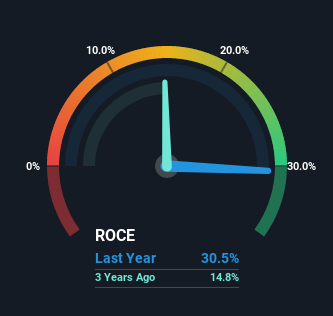Why The 30% Return On Capital At Kothari Petrochemicals (NSE:KOTHARIPET) Should Have Your Attention
If we want to find a potential multi-bagger, often there are underlying trends that can provide clues. Firstly, we'll want to see a proven return on capital employed (ROCE) that is increasing, and secondly, an expanding base of capital employed. Basically this means that a company has profitable initiatives that it can continue to reinvest in, which is a trait of a compounding machine. So when we looked at the ROCE trend of Kothari Petrochemicals (NSE:KOTHARIPET) we really liked what we saw.
What is Return On Capital Employed (ROCE)?
For those that aren't sure what ROCE is, it measures the amount of pre-tax profits a company can generate from the capital employed in its business. To calculate this metric for Kothari Petrochemicals, this is the formula:
Return on Capital Employed = Earnings Before Interest and Tax (EBIT) ÷ (Total Assets - Current Liabilities)
0.30 = ₹457m ÷ (₹1.9b - ₹366m) (Based on the trailing twelve months to December 2021).
Thus, Kothari Petrochemicals has an ROCE of 30%. That's a fantastic return and not only that, it outpaces the average of 18% earned by companies in a similar industry.
View our latest analysis for Kothari Petrochemicals

Historical performance is a great place to start when researching a stock so above you can see the gauge for Kothari Petrochemicals' ROCE against it's prior returns. If you want to delve into the historical earnings, revenue and cash flow of Kothari Petrochemicals, check out these free graphs here.
How Are Returns Trending?
Investors would be pleased with what's happening at Kothari Petrochemicals. The data shows that returns on capital have increased substantially over the last five years to 30%. The company is effectively making more money per dollar of capital used, and it's worth noting that the amount of capital has increased too, by 88%. So we're very much inspired by what we're seeing at Kothari Petrochemicals thanks to its ability to profitably reinvest capital.
On a related note, the company's ratio of current liabilities to total assets has decreased to 20%, which basically reduces it's funding from the likes of short-term creditors or suppliers. So shareholders would be pleased that the growth in returns has mostly come from underlying business performance.
The Bottom Line
In summary, it's great to see that Kothari Petrochemicals can compound returns by consistently reinvesting capital at increasing rates of return, because these are some of the key ingredients of those highly sought after multi-baggers. And with the stock having performed exceptionally well over the last five years, these patterns are being accounted for by investors. Therefore, we think it would be worth your time to check if these trends are going to continue.
On a final note, we've found 2 warning signs for Kothari Petrochemicals that we think you should be aware of.
Kothari Petrochemicals is not the only stock earning high returns. If you'd like to see more, check out our free list of companies earning high returns on equity with solid fundamentals.
Valuation is complex, but we're here to simplify it.
Discover if Kothari Petrochemicals might be undervalued or overvalued with our detailed analysis, featuring fair value estimates, potential risks, dividends, insider trades, and its financial condition.
Access Free AnalysisHave feedback on this article? Concerned about the content? Get in touch with us directly. Alternatively, email editorial-team (at) simplywallst.com.
This article by Simply Wall St is general in nature. We provide commentary based on historical data and analyst forecasts only using an unbiased methodology and our articles are not intended to be financial advice. It does not constitute a recommendation to buy or sell any stock, and does not take account of your objectives, or your financial situation. We aim to bring you long-term focused analysis driven by fundamental data. Note that our analysis may not factor in the latest price-sensitive company announcements or qualitative material. Simply Wall St has no position in any stocks mentioned.
About NSEI:KOTHARIPET
Kothari Petrochemicals
Engages in the manufacture and sale of petrochemical products in India and internationally.
Flawless balance sheet average dividend payer.
Market Insights
Weekly Picks


Crazy Undervalued 42 Baggers Silver Play (Active & Running Mine)


Fiducian: Compliance Clouds or Value Opportunity?

Willamette Valley Vineyards (WVVI): Not-So-Great Value
Recently Updated Narratives

After the AI Party: A Sobering Look at Microsoft's Future

THE KINGDOM OF BROWN GOODS: WHY MGPI IS BEING CRUSHED BY INVENTORY & PRIMED FOR RESURRECTION


The "Molecular Pencil": Why Beam's Technology is Built to Win
Popular Narratives


MicroVision will explode future revenue by 380.37% with a vision towards success


NVDA: Expanding AI Demand Will Drive Major Data Center Investments Through 2026




